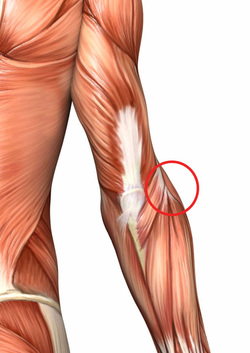
TENNIS ELBOW (lateral epicondylitis)
Lateral epicondylitis, or tennis elbow as it’s commonly known, is a chronic overuse tendon injury resulting in pain and inflammation in the outer tendons of the forearm. This condition is often caused by repetitive, forceful extension of the elbow, supination (turning the forearm to face your palm up) and radial deviation (swinging your forearm outwards away from your body). People participating in sports such as tennis, golf, wheelchair athletes, carpenters and barristas often present with tennis elbow.
How do I know I have it?
Symptoms such as pain slowly increasing on the outside of the elbow, less frequently sudden onset of pain, pain felt when shaking hands and gripping may be felt. Wrist weakness felt when opening doors or jars, lifting and/or using toothbrushes or dining may be present. Forceful movements of the wrist can also aggravate the problem.
How can massage or pilates help?
The goals of treatment are to reduce pain and inflammation, promote healing and decrease stress on the injured elbow. Remedial massage techniques are used to stretch and strengthen the muscles surrounding the injured elbow, with any activity that may aggravate the problem to be avoided. Sometimes an elbow strap is worn to help stabilise the upper elbow joint and to avoid any sudden movements. Your remedial therapist may also assess your wrist and shoulder region for any contributing factors.
In more serious cases non-steroidal anit-inflammatories, cortisone injection or shock wave therapy conducted by your GP or physiotherapist may be of benefit.
What can I do to prevent injury?
Continuing to stretch and strengthen the elbow region after the injury has resolved, avoiding repetitive movements of the wrist and forearm, as well as stabilising/holding your wrist strong during use can all help to prevent re-injury. Visit our FREE Workouts page and go to Arm & Chest Stretches to download a basic tennis elbow stretch.
Lateral epicondylitis, or tennis elbow as it’s commonly known, is a chronic overuse tendon injury resulting in pain and inflammation in the outer tendons of the forearm. This condition is often caused by repetitive, forceful extension of the elbow, supination (turning the forearm to face your palm up) and radial deviation (swinging your forearm outwards away from your body). People participating in sports such as tennis, golf, wheelchair athletes, carpenters and barristas often present with tennis elbow.
How do I know I have it?
Symptoms such as pain slowly increasing on the outside of the elbow, less frequently sudden onset of pain, pain felt when shaking hands and gripping may be felt. Wrist weakness felt when opening doors or jars, lifting and/or using toothbrushes or dining may be present. Forceful movements of the wrist can also aggravate the problem.
How can massage or pilates help?
The goals of treatment are to reduce pain and inflammation, promote healing and decrease stress on the injured elbow. Remedial massage techniques are used to stretch and strengthen the muscles surrounding the injured elbow, with any activity that may aggravate the problem to be avoided. Sometimes an elbow strap is worn to help stabilise the upper elbow joint and to avoid any sudden movements. Your remedial therapist may also assess your wrist and shoulder region for any contributing factors.
In more serious cases non-steroidal anit-inflammatories, cortisone injection or shock wave therapy conducted by your GP or physiotherapist may be of benefit.
What can I do to prevent injury?
Continuing to stretch and strengthen the elbow region after the injury has resolved, avoiding repetitive movements of the wrist and forearm, as well as stabilising/holding your wrist strong during use can all help to prevent re-injury. Visit our FREE Workouts page and go to Arm & Chest Stretches to download a basic tennis elbow stretch.
